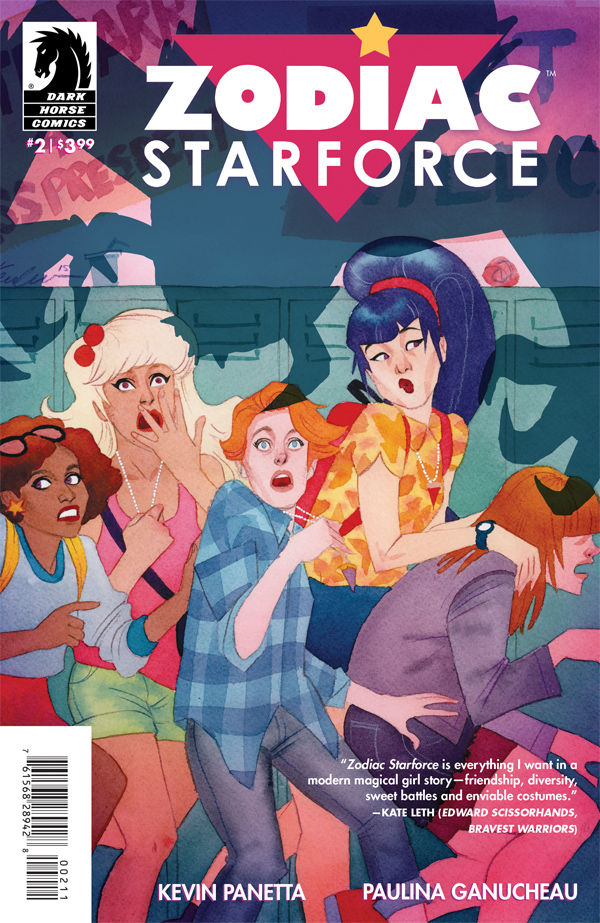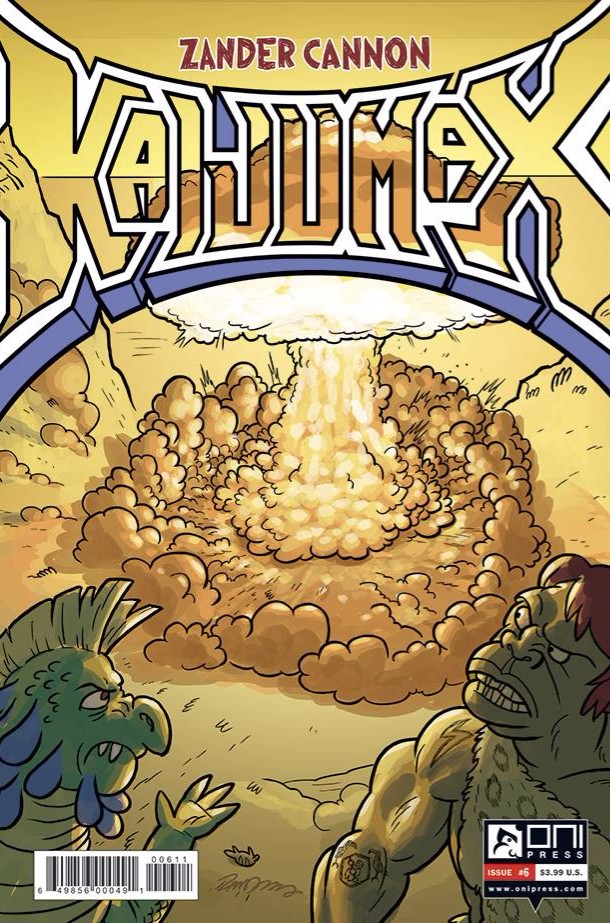By Molly Jane Kremer, Scott Southard, and Jarrod Jones. Our Week In Review collects our thoughts on the comics that demand attention. Do you have a deep-rooted desire to know what we think about all your favorite books? Well. This is where you need to be.
Dark Horse Comics/$3.99
Written by Kevin Panetta.
Art by Paulina Ganucheau; Color by Savanna Ganucheau.
SS: Straightforward intro: I do not believe I fall into the target demographic of Zodiac Starforce. It didn’t register too hard when I first saw it on shelves, and I wasn’t particularly excited to pick up the book and give it a read. Then I picked up the book and gave it a read. Now life is dichotomously different than it was before. Zodiac Starforce turned me into a fanboy within the first few pages, and now I need more. It’s sneakily brilliant, smart as hell, and way too fun.
One of the spinal structures of Zodiac Starforce is its pointed representation of tough, smart, female leads from a major publisher. It’s clearly aimed at the kind of characters it represents (young women), but it doesn’t contain itself to a single demo group by playing possum and dumbing itself down. Because its target audience doesn’t need their comics to be diluted, and Kevin Panetta & Co. know this. The strength of this comic is its firm belief in treating the audience as the resourcefully astute human beings that they are, which opens the doors to anyone who wants to give the book a try.
This attitude shines when the dialogue has characters speaking like human beings (imperfect grammar, superfluous “like’s” interspersed with thoughtfully placed “like’s” in the narration) and dealing with the topics at hand. It reads like reality rather than a sequence of plot devices or narrative progression. Zodiac Starforce progressively takes for granted the fact that the characters existed before the storyline started, which gives the world a lived-in sense of believability.
The heavily produced, multi-layered digital art design is stunning. Each panel pops like crazy with a neon contrast simmering on the page. The characters have their own style, differentiating them from each other while maintaining a palette that remains overarchingly connected. It’s fashionista pink, done with style and purpose.
Zodiac Starforce compiles carefully-used conversational language tethered to some solid dynamic storytelling techniques, a diverse set of characters (and a Macho Man Randy Savage reference tucked in for good measure), and the package comes together as a cohesive whole. It deals with weighty issues surrounding the worth of human lives as well as the skull-crushing difficulty of attempting to navigate the social and romantic politics of high school life. (Also, the worth of human lives.) Zodiac Starforce is a smarter version of the classic teen superhero trope, because it recognizes that teenagers are attentive, complex humans, and not just silly, tech-obsessed versions of adults. Anytime humans are portrayed as multi-faceted people in comics, it’s worth taking note. It just so happens that these humans are kicking interdimensional ass from the confines of a high school gymnasium. It doesn’t matter if there’s a test the next day or there was a scuffle by the lockers earlier, they’re all just trying to do what’s right for themselves and for everyone else. It’s silly to think this wouldn’t deeply resonate with anyone who happens to pick up this book.
9 out of 10
Oni Press/$3.99
Written by Zander Cannon.
Art by Zander Cannon.
SS: Remember that fictional, Barney-fied version of a Sopranos episode you always wanted to read about? No? Well, it’s been here all along, and as its first arc finally comes to a close, one of the more chilling stories being published today wraps up.
Forthcoming in the explanation of its literary proclivities, Kaijumax is nothing if not direct. Throughout the series, we’ve been explicitly told (as well as plenty of implicit allusions) that the monsters are metaphors for humanity’s scientific hubris and that our protagonist is an anti-hero. It’s a caricaturistic look at a high security island penitentiary for world-destroying monsters, ruled over by vice-fueled, Power Ranger-adjacent prison guards. On top of that, prison power structures mimic those of real life, with bureaucracies that concern themselves with gangs, drugs, and shady deals with the guards. What’s most interesting about Kaijumax isn’t the cute parallels it makes with real prison life, but that it is a direct, dramatic look at how prison functions in a modern society, and how the good guys and the bad guys are all pretty much the bad guys.
If it weren’t for the exaggerated cartoon surface and the goofy curse-replacement terms, Kaijumax could easily be mistaken for a comic version of Oz. There’s an ensemble cast of inmates and guards, each with their own history and complicated web of inter-monster relationships. The narrative recaps that start each issue lend credence to the soap opera style that Zander Cannon uses to move each monster through the narrative tumult, creating small stories between that connect every character through consequence.
And like any good season ender, Kaijumax #6 is the episode of the soap opera where everything starts to collide and fall to pieces. The deaths of major characters have come to a head and you start to wonder how they’ll continue. The cast is quickly disappearing and fracturing, and the structures of setting are crumbling fast. Also, a nuclear bomb went off somewhere in there. It’s the fun part about all storytelling: the blowoff of buildup that seemed so unnecessary and superfluous during the first run through. In fact, I remember reading the first few issues and thinking that the cast was too large, and the exposition was too heavy for each character. I thought there was too much to keep straight about the whole series. By the time this issue rolled around, I’d finally gotten a grip on the entirety of the cast, and Caddon had to go and blow it all up (quite literally).
I don’t think I’ll ever be in love with the cartoon monster veneer of Kaijumax, but underneath the cutesy dino skin is a truly dark, human story about prison life, and the dehumanization caused by a system that’s just as corrupt as the criminals it seeks to contain. This book is deep and it is chilling. I hope the drama continues and we get to see what life is like on the outside.
8.5 out of 10
DC Comics/$4.99
Written by James Tynion IV.
Art by Roge Antonio; colors by Dave McCaig.
JJ: Seems almost a distant memory now, but you can bet your Bat-boots that Arkham Manor happened. What was a noble attempt at shaking Batman’s world to its core (chiefly, by removing his home from him and stocking it full of his worst enemies) quickly got lost under the weight of other more prominent changes that followed the stupendously executed Batman Eternal. While the book itself was a narrative success (even if it did have Alan Grant’s run on Shadow of the Bat coursing through its veins), finance and fate held that its pages would be forever shut. But the frightening concepts that bolstered the book remained.
So, whither Arkham Manor? Batman Annual #4 is here to figure that out.
And leave it to James Tynion IV, showrunner of the imminent maxi-series, Batman and Robin Eternal, to iron the whole mess out without losing sight of what’s propelling Batman’s world these days. Tynion’s solo-Batman adventures are always something to look forward to: when left to his own devices, he has a tendency to make things smaller and vastly more intimate, giving his characters the chance to develop both nuance and depth. Batman Annual #4 is yet another example of his fine work, but he has so much more than mere nuance to offer us. (Though seeing Alfred hint at Bruce Wayne and Julie Madison’s wedding is more than enough to stick a lump in your throat, it’s so damn cute.)
There are Tynion’s reliably clever flourishes too, the ones that set him apart from other writers operating in DC’s belfry (the electrified chandelier in the Manor’s study is a particularly brilliant touch). There’s also the same brand of immediate terror for which Tynion has become so well known, where an amnesiac Bruce Wayne finds himself at the mercy of three of his most powerful enemies (Mr. Freeze, Clayface, and, making his first serious moves since Scott Snyder and Greg Capullo’s Zero Year, The Riddler). It’s a devilishly clever hook. James Tynion IV should always be allowed to write Batman.
Tynion’s grasp on this world, coupled with Roge Antonio’s moody, atmospheric renderings, should be enough to sell this Annual. But then we find that the creators have made room to broach the innate hypocrisy that exists in Bruce Wayne’s former campaign against crime, or at least, that’s how his Rogues perceive it: witnessing three enemies coming into Batman’s home to enact a grudge by a misplaced sense of righteousness is a gorgeous flip on the typical Batman tropes. It’s heavy, psychologically daunting stuff coupled with the perfect amount of sardonic wit. You won’t be able to set it down.
8 out of 10
Agree? Disagree? What books are YOU reading this week? We want to know! Tell us about those feelings of yours in the comments section below.
















